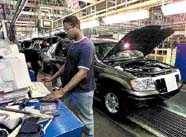U.S. automakers push more products; Is it enough to survive?
Automakers seem to be a little frantic these days. At this season's major auto shows in Detroit, Chicago, Geneva and New York, they offered vehicles powered by diesel fuel, hybrid systems and ethanol, massive pickups and tiny subcompacts, nostalgic muscle cars and futuristic crossovers.

Finding the right formula to whet car buyers' appetites has become more essential than ever. Automakers are responding with more products to fill every niche, which is a boon for consumers but painful and expensive for U.S. automakers.
High gasoline prices also intensify the risks for General Motors Corp. and Ford Motor Co., whose operating profits come primarily from less-fuel-efficient pickup trucks and sport utility vehicles.
"There's a lot of things GM and Ford are still grappling with if they're going to adapt to these niche markets," said Erich Merkle, director of forecasting for the consulting firm IRN Inc. "They can be profitable, but they're going to have to change the entire way they do business."
In a recent speech, Ford's Americas President Mark Fields said there will be 300 nameplates in the U.S. market by the end of the decade, up from 215 in 2002. The explosion is apparent at the auto shows. In Detroit alone, 33 vehicles made their worldwide debuts.
Japanese and South Korean automakers are better equipped to make many different models because they have lower labor costs and newer, more flexible plants that can build multiple products on the same line. When Honda Motor Co. found its Ridgeline pickup was not meeting sales targets, it ramped up production of more popular vehicles like the Odyssey minivan made at the same plant, Merkle said.
Ford and GM are working on making their operations leaner, by cutting thousands of jobs, closing plants, and using the same underpinnings on multiple vehicles, but it will take time before they can match the level of their rivals. Fields said this past week that Ford expects 82 percent of its assembly facilities to be flexible by 2008, up from 38 percent in 2004, reports AP.
O.Ch.
Subscribe to Pravda.Ru Telegram channel, Facebook, RSS!


